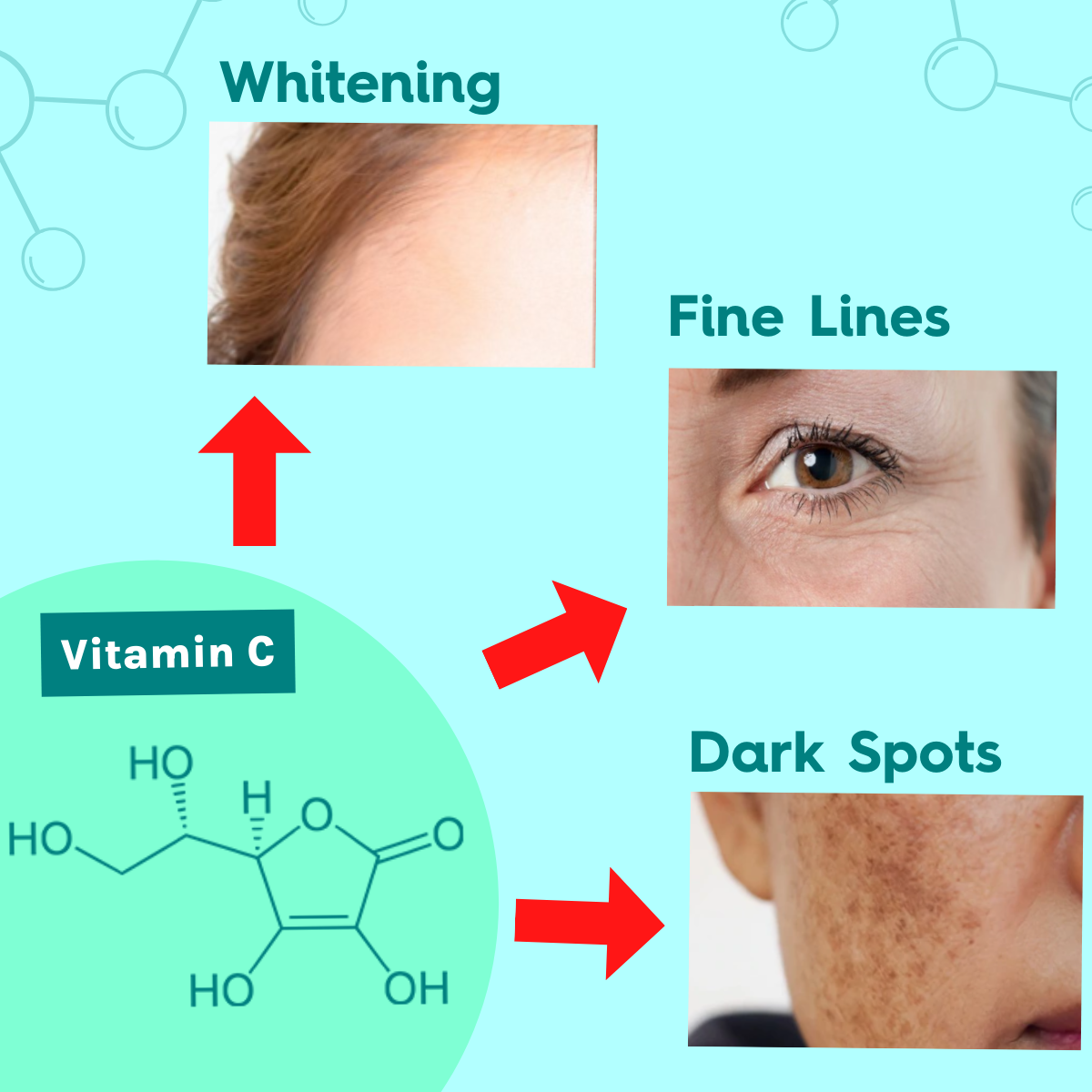Every time we mention vitamin C in general, the first few things that may appear in your mind could be citrus fruits like oranges or strawberries that are astoundingly rich in this particular nutrient. But no, we are not referring to those. We are talking about the pure form of vitamin C in skincare, such as L-ascorbic acid (LAA) along with other derivatives like ascorbyl glucoside, magnesium ascorbyl phosphate and sodium ascorbyl phosphate.

It is quite known that out of the endless ingredients that can truly benefit the skin, this potent, zesty antioxidant is right on top of every skin specialist’s personal list. Countless dermatology research has pointed out the positive results of vitamin C when it is applied topically. Its powerful qualities that can protect, recover, firm and whiten the skin never goes unnoticed and is very much well-regarded by many.
So what is so special about it? Below is everything you need to know about what vitamin C does to your skin, from acting as a shield against the sun to keeping your radiance intact day to night. Now prepare to turn your head away from the so-called “miraculous ingredients” and look back on the ordinary, yet really effective vitamin C.
Vitamin C in Photoprotection
Everyone knows that the sun is our skin’s number one enemy. With a wavelength of 320-400 nm, the UVA (Ultra-violet A rays) can penetrate deep into the skin and mutate collagen, elastin, proteoglycans and other living cell structures. UVB (Ultra-violet B rays) on the other hand, has the ability to burn the top layer of your skin and create reactive oxygen species (ROS) that causes skin cancer with its wavelength of 290-320 nm.
So, is using sunscreen enough? Generally speaking, sunscreen agents does protect the skin BEFORE UVA and UVB hit on it. But Vitamin C is the one that carries out the recovering functions AFTER UV rays damage the skin. There is even research suggesting that daytime application of L-ascorbic acid enhances the effectiveness of the later-applied sunscreen by 4 to 8 times.
Therefore, Vitamin C is definitely the best helper for maximizing photoprotection. But keep in mind that it is NOT a sunscreen agent. A chemical sunscreen agent absorbs the UV rays while a physical sunscreen agent reflects them. Vitamin C does neither of the two.

Let’s all dive a little deeper into the physiological mechanism. UV light from the sun can create a reactive oxygen species (ROS) inside the skin in the form of peroxide, singlet oxygen and superoxide ion. These radicals will proceed to trigger reactions that damage the inner cells and even possibly alter your cellular DNA. Suffice to say, they are the sneaky culprits behind all those pesky dark spots, dullness, sagging skin and wrinkle problems that have been haunting most innocents day and night. This happens due to oxidative stress that is caused by the contrast between the number of free radicals and the skin’s ability to detoxify their harmful effects.
Now vitamin C, like other antioxidants, contribute to the balance by successively donating electrons to neutralize the free radicals. These electrons will strip down the radicals defences, so they don’t wreak havoc on your collagen, elastin and other cellular structures.
In midst of writing this article, we suddenly got curious as to what extent vitamin C can do to increase the level of photoprotection. Imagine our thrill when we discovered that just a topical application of 10% vitamin C is enough to show a statistical reduction in UVB-induced redness by 52% and sunburn cell formation by up to 60%. This information is according to a journal that is authored by the reputable Dr. Farris from the Department of Dermatology in Tulane University School of Medicine. In short, this piece of knowledge definitely heightened our understanding of vitamin C serum's perks before the usage of sunscreen.
While applying vitamin C to the skin offers incredible photoprotection, we cannot exactly say the same for the consumption of its supplements. This does not mean that it wouldn’t give you any benefits, simply that it is not enough to protect your melanin from the sun. Remember that applying sunscreen together with a vitamin C serum ultimately provides the best sun protection compared to relying on eating any supplement alone.
Another interesting revelation is that the cosmetic industry famous CEF (15% vitamin C, 1% vitamin E and 0.5% ferulic acid) triple combination formula is very effective in the lessening of chronic and acute sun damage.

The Mad Hippie Hydrating Facial Sunscreen SPF 25+ Broad Spectrum on our website is one of the proudest creations of Mad Hippie that uses the CEF formula after years of careful experimentation. If you already have one, you will know that you can get enhanced sun protection with a whopping SPF 25+ that shields your complexion from harmful UV rays day and night, rain or shine.
Vitamin C in Collagen Regeneration
Your high school biology class teacher might have taught you that deficiency in vitamin C leads to a disease known as scurvy. It is a famous illness that comes with symptoms like painful sensation, bleeding and swelling of the gums. As a matter of fact, the gums in our mouth is actually made out of mucosal tissue built by rows and rows of collagen. What does collagen need? Vitamin C! Therefore, insufficient intake of vitamin C will disrupt the synthesis of collagen, which eventually leads to signs of scurvy.
It is no doubt that vitamin C is very important for the biosynthesis of the structural protein collagen. During the hydroxylation of collagen molecules, vitamin C serves as the pivotal cofactor for enzymes prolysyl and lysyl hydroxylase, which are responsible for inter-linking and strengthening collagen molecules to support the epidermis and dermis layers of the skin.

Besides lending a hand in the hydroxylation of collagen molecules, studies show that vitamin C can directly activate procollagen messenger RNA (or mRNA). It is a subtype of RNA that carries DNA code to other portions of the cells to begin the transcription process for collagen synthesis.
In layman’s terms, topical use of vitamin C without enough strength can reduce fine lines and wrinkles, smoothen the skin’s texture and makes it firmer from the within, thanks to collagen reproduction. Research also suggests that it takes at least 12 weeks for the results to start showing so remember that consistency is key.
Vitamin C in Depigmentation
Now that you are aware of how vitamin C is essential in protecting the skin from radical damage caused by UV light and in regenerating collagen, let’s talk about what it does to depigmentation. We purposefully positioned this after the first two because a lot of us already know how vitamin C is effective in brightening skin tones and fading brown spots. But do you know how it works exactly?
Truth be told, cosmetic brands love to advertise vitamin C as a skin brightener rather than a photo-protector or collagen synthesizer. The sole reason is simply that many consumers tend to focus on brightening their skin over most skin concerns. This can be seen from how a lot of whitening treatments are in higher demand as compared to other products.

It is true that Vitamin C is a wonderful depigmenting agent. However, not all vitamin C products can easily brighten skin tone and reduce brown spots. There are also other factors that influence how it works such as the concentration, pH value, product packaging, penetration enhancers and stabilizers in the formulation. Beautiful marketing reveals no truth about the efficacy of a vitamin C product.
To be a truly dynamic depigmenting agent, vitamin C in a product has to penetrate much deeper into the skin to interrupt the process of melanogenesis. It is the physiological step that produces melanin; the basic determinant of skin colour. Your skin tone gets darker as the concentration and distribution of melanin increase.
The entire mechanisms regulating melanogenesis is complicated. Vitamin C does not stop everything at once and it usually interferes in one of the early steps for the formation of melanin.
What does this call for? A help! Tyrosinase is an important copper-containing enzyme that aids the creation of melanin. Vitamin C contributes to skin brightening by interacting with copper ions at the tyrosinase-active site, thereby inactivating the tyrosinase enzyme. As a result, melanogenesis is interrupted, melanin couldn’t be formed, and you will enjoy a brighter and healthier skin tone.
Once again, the melanin synthesis process happens very deep within the skin. A top-rated vitamin C product should have penetration enhancers that are effective in delivering vitamin C (preferably L-ascorbic acid) directly into the skin. Almost all beauty brands use alcohol as a penetrating agent because it is an inexpensive ingredient, even though it can be irritating for the skin.

If you prefer a milder alternative, The Ordinary’s Ethylated Ascorbic Acid 15% Solution is a great choice for anyone with sensitive skin. It uses 3-O-ethyl ascorbic acid that can be mixed with any formulation easily for fast penetration into the skin and can still provide you with just the right amount of gentle touch.
Vitamin C in Anti-Inflammation
That is not all! After countless research, vitamin C is also now widely acknowledged for its anti-inflammation qualities. It has been proven that this particular vitamin has the ability to inhibit the pro-inflammatory cytokines (TNF-alfa, IL1, IL6 and IL8).
The pH value is the keynote in this case. L-ascorbic acid needs an acidic pH to stay potent and active in a formulation. But overly-acidic products have the tendency to burn the skin or provoke signs of sensitivity, which is where the pH value comes into action. A product with L-ascorbic acid should have a pH of 3.0 to 3.5 in order for it to not be inflammatory. This range is perfectly well-adjusted for the product to stay useful yet within the tolerance of our skin.

Our Triple C Night Cream by Mad Hippie is an amazing example of a product with vitamin C that is tender to the epidermis. The exceptional combination of three highly stabilized derivatives of vitamin C intensely hydrates skin, while infinitely releasing active compounds that sustain its radiance.
We hope this article is helpful to help you decide the vitamin C products you are interested in trying later! Vitamin C is certainly a smart skincare investment. If the product is considerately packaged, formulated with vitamin C derivatives that are research-proven to perform beautifully on the skin and are at an appropriate pH level, do not be shy to give it a try! Always remember that a little vitamin goes a long way.
Your Sharing: What are some of your favourite Vitamin C products from Worthee Cosmetics? How has your skin been reacting to them so far?
References
Farris PK. Cosmetical Vitamins: Vitamin C. In: Draelos ZD, Dover JS, Alam M, editors. Cosmeceuticals. Procedures in Cosmetic Dermatology. 2nd ed. New York: Saunders Elsevier; 2009. pp. 51–6.
Fitzpatrick RE, Rostan EF. Double-blind, half-face study comparing topical vitamin C and vehicle for rejuvenation of photodamage. Dermatol Surg 2002;28:231-236.
Humbert PG, Haftek M, Creidi P, et al. Topical ascorbic acid on photoaged skin. Clinical, topographical and ultrastructural evaluation: double-blind study vs. placebo. Exp Dermatol 2003;12:237-244.
Nusgens BV, Humbert P, Rougier A, et al. Topically applied vitamin C enhances the mRNA level of collagens I and III, their processing enzymes and tissue inhibitor of matrix metalloproteinase 1 in the human dermis. J Invest Dermatol 2001;116:853-859
Raschke T, Koop U, Dusing HJ, et al. Topical activity of ascorbic acid: from in vitro optimization to in vivo efficacy. Skin Pharmacol Physiol 2004;17:200-206.
Tebbe B, Wu S, Geilen CC, Eberle J, Kodelja V, Orfanos CE. L-ascorbic acid inhibits UVA-induced lipid peroxidation and secretion of IL-1alpha and IL-6 in cultured human keratinocytes in vitro. J Invest Dermatol 1997;108:302-306.
Traikovich SS. Use of topical ascorbic acid and its effects on photodamaged skin topography. Arch Otolaryngol Head Neck Surg 1999;125:1091-1098.


